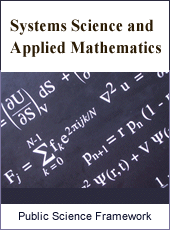Systems Science and Applied Mathematics
Articles Information
Systems Science and Applied Mathematics, Vol.1, No.1, Aug. 2016, Pub. Date: Aug. 19, 2016
The Symmetries of Solutions of Partial Differential Equations
Pages: 8-12 Views: 4249 Downloads: 641
[01]
Rufina Abdullina, Department of Physics and Mathematics, Sterlitamak Branch of the Bashkir State University, Sterlitamak, Russia.
[02]
Alena Agafonova, Department of Physics and Mathematics, Sterlitamak Branch of the Bashkir State University, Sterlitamak, Russia.
The first general solution of the problem of Сaushy for an extensive class of partial differential equations was given by Riemann almost a century ago in his well-known paper on the propagation of sound waves of finite amplitude. Although stated only for certain special equations, it is applicable to any linear equation of hyperbolic type of the second order in two independent variables; it depends ultimately on finding a certain subsidiary function, often called the Riemann function, which is the solution of a characteristic boundary value problem for the adjoint equation. This paper is of a synthetic nature, being a result of combining Riemann’s method for integrating second-order linear hyperbolic equations with Lie’s classification of such equations. In paper was found the solution of the Cauchy problem by the Riemann method for a hyperbolic equation. It was also shown the invariance of the Riemann function relatively to the symmetry of the fundamental solutions.
Problem Cauchy, Riemann’s Function, Hyperbolic Equation, Group Analysis
[01]
CRC Handbook of Lie Group Analysis of Differential Equations. Editedby N. H. Ibragimov. CRC Press. USA: Vol. 1. Symmetries, exact solutions, and conservation laws. 1994. 429 p. Vol. 2. Applications in engineering and physical sciences. 1995. 546 p. Vol. 3. New trends in theoretical developments and computational methods. 1996. 536 p.
[02]
Ibragimov N. H. Elementary Lie Group Analysis and Ordinary Differential Equations. John Wiley & Sons Ltd. Great Britain. 1999. 347 p.
[03]
Bluman G. W., Anco St. C. Symmetry and Integration Methods for Differential Equations. Springer–Verlag New York, Inc. 2002. 419 p. (Applied Mathematical Sciences. Vol. 154).
[04]
Cantwell Br. J. Introduction to Symmetry Analysis. Cambridge. Cambridge University Press. 2002. 654 p.
[05]
Euler N., Steeb W.–H. Continuous Symmetries, Lie Algebras and Differential equations. Leipzig. Wissenschaftsverlag. 1992. 320 p.
[06]
R. Gorenfloand S. Vessella, Abel integral Equations: Analysis and Application, Springer-Verlag, Berlin-NewYork, 1991.
[07]
Jerri A. Introduction to Integral Equations with Applications. Wiley, New York, 1999.
[08]
Davis H. T. Introduction to Nonlinear Differential and Integral Equations, 1sted., Dover Publications, Inc., NewYork,1962.
[09]
Manzhirov A. V. and Polyanin A. D. Handbook of Integral Equations: Solution Methods [in Russian], Factorial Press, Moscow, 2000.
[10]
Deutsch M., Beniaminy I. Derivative-free Inversion of Abel’s Integral Equation. Applied Physics Letters 41: pp. 27-28, 1982.
[11]
Anderssen R. S. Stable Procedures for the Inversion of Abel’s Equation. Journal of the Institute of Mathematics and its Applications 17: pp. 329-342, 1976.
[12]
Minnerbo G. N., Levy M. E. Inversion of Abel’s Integral Equation by Means of Orthogonal Polynomials. SIAM Journalon Numerical Analysis 6: pp. 598-616, 1969.
[13]
J. D. Tamarkin, “On integrable solutions of Abel’s integral equation,” Annals of Mathematics, vol. 31, no. 2, pp. 219–229, 1930.
[14]
A. C. Pipkin, A Courseon Integral Equations, Springer–Verlag, NewYork, 1991.
[15]
Akimov A., Galiaskarova G. The solution of the Darboux problem for the telegrath equation with deviation from the characteristic, International Journal of Pure and Applied Mathematics. 2015. Т. 103. № 2. С. 377-383.
[16]
R. Naz and F. M. Mahomed “Dynamic Euler-Bernoulli Beam Equation: Classification and Reductions”, Hindawi Publishing Corporation Mathematical Problems in Engineering, Volume 2015(2015).

ISSN Print: Pending
ISSN Online: Pending
Current Issue:
Vol. 2, Issue 2, April Submit a Manuscript Join Editorial Board Join Reviewer Team
ISSN Online: Pending
Current Issue:
Vol. 2, Issue 2, April Submit a Manuscript Join Editorial Board Join Reviewer Team
| About This Journal |
| All Issues |
| Open Access |
| Indexing |
| Payment Information |
| Author Guidelines |
| Review Process |
| Publication Ethics |
| Editorial Board |
| Peer Reviewers |


